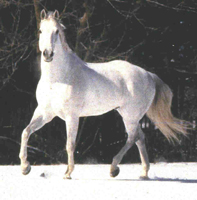Horse
The horse is the animal for The New Year's Day of the Extra Day of the Year (the day after the Winter Solstice). The body of the Unicorn, which represents all of the Five Stations of the Calendar Year) is a Horse because it is the animal most sacred to the Moon and to the Goddess of Childbirth.
 From the earliest of time, the Horse has been the provider of power and transport and has probably had the closest relationship with humans of all the animals. The Horse has been associated with both Sun and Moon and many deities, but is really most closely identified with the land itself. Horses represent strength, swiftness, beauty, sexuality and fertility.
From the earliest of time, the Horse has been the provider of power and transport and has probably had the closest relationship with humans of all the animals. The Horse has been associated with both Sun and Moon and many deities, but is really most closely identified with the land itself. Horses represent strength, swiftness, beauty, sexuality and fertility.
The Horse appears in many works of art. One well known to all Celtic people is the giant white Horse carved into the hillside at Uffington in Berkshire. Archeology points to the importance of a sacrificial Horse in early ritual, and the kingship ceremonies of ancient Ireland, sadly involved the sacrifice of a white mare as a symbol of the kingdom.
Epona, "Divine Horse"; "The Great Mare"; Goddess of horses; Mother Goddess. Associated with fertility, maternity, protectress of horses, horse-breeding, prosperity, dogs, healing springs, crops.
She is a popular equestrian goddess closely concerned with healing, and with the fertility of domestic animals. She is possibly the only Celtic goddess to have been worshipped in Rome itself and her popularity was spread throughout the regions of Roman occupation. Her festival was celebrated on December 18.
Epona is typically seen with mares and foals, usually riding sidesaddle or merely in association with horses. She also holds a cornucopia with sheaves of grain and other fruits suggesting another role as a vegetation goddess.
Epona was also a Goddess able to bestow sovereignty on Celtic kings. Jean Markdale, author of the superb work on Celtic Goddesses, "The Women of the Celts", believes she may have been the first mother Goddess of Celts, predating even Danu.
In Scotland she is referred to as Bubona, and in England Lady Godiva is thought to be another version. Carvings of Epona also appear in Germany, and the Anglo-Saxons may also have adopted her in the form of their horse Goddess, Horsa. Other horse-associated Goddesses such as Macha, Edain, Rhiannon, and Maeve may have grown out of her myths.
The battle pennants of the Saxons were typically made from the tails of white Horses. The white Horse is still a common theme in arms and symbols from areas of the country with strong Saxon influences.
Magical Horses were ways in which mortals could travel between the worlds - a method also used in many shamanic traditions. The Celtic sun god, Lugh, was the first to introduce horsemanship into Ireland, but the most famous Horse in Irish myth is Aonbharr, the mount of the sea-god Manannan, who made any rider invulnerable. She carried away the hero Conan to the Celtic Otherworld, from where he had to be rescued.
The Manx 'glashtin' were water-horses, identical to ordinary Horses except that their hooves were backwards and they would trick mortals into mounting, then rush back to the sea, drowning the riders. White-tipped waves breaking against the shore are even today referred to as `white Horses'.
In Norse mythology, the god Odin possessed a magical stallion named Sleipnir, who could outrun every other Horse and could run across water as though it were dry land. On the death of Baldur, the much loved and revered god of light, it was Sleipnir who carried Odin's son Hermod to the Norse Underworld to beg the goddess Hel for his return.
Things associated with Horses are: emotions, creativity, healing, sexuality, companionship, practicality,hard Work, and emotional strength.
The most important spiritual meaning for Horse is that of a bridge between the worlds. The Horse does this by creating a bridge of awareness between both worlds, and offers guidance as well as companionship along the way. It easy to see why the Horse stands at the First Station of the New Year.